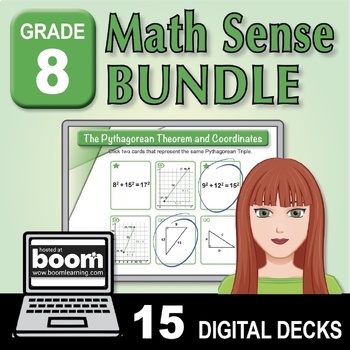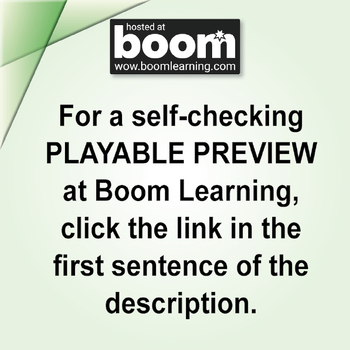BOOM Digital Matching: Grade 8 Math Sense Bundle of 15 Decks
K8MathSense
3.2k Followers
Grade Levels
8th - 9th
Subjects
Resource Type
Standards
CCSS8.EE.A.2
CCSS8.F.A.2
CCSSMP3
Formats Included
- PDF
- Internet Activities
Pages
15 decks of 20 online screens
K8MathSense
3.2k Followers
Compatible with Digital Devices
The Teacher-Author has indicated that this resource can be used for device-based learning.
Description
CLICK HERE to link to a list of 15 playable previews. These BOOM LEARNING activities provide 8th graders practice with integer exponents, square and cube roots, linear functions, volume, angles, Pythagorean theorem, repeating decimals, and more. You'll get 15 decks, each with 20 self-checking screens that show playing cards with various representations. The 4-character codes in set titles stand for the grade, CCSS domain, cluster, and goal. These decks are also available separately.
- Boom pages are self-checking and hosted online by Boom Learning. You are buying a PDF with a link and redemption code for the 8th grade Math Sense bundle at Boom Learning.
- Students gain math sense as they match two of six cards. Students can work alone, with a partner, or with a SPED or ESL aide or tutor.
- The playing cards shown are the same as in the printable game card sets here on TPT. See the card game bundles for Grade 6, Grade 7, and Grade 8.
- The 4-character codes in set titles stand for the grade, CCSS domain, cluster, and concise goal. CLICK HERE to view and download the free Grade 8 Goals Checklist.
ABOUT BOOM CARDS (Important to read!)
- To use Boom Cards, you must be connected to the Internet and have a subscription (free or paid). Boom Cards play on modern browsers (Chrome, Safari, Firefox, and Edge). Apps are available for modern Android, iPads, iPhones, and Kindle Fires.
- If you are new to Boom Learning, you will be offered a free trial of our premium account. Read here for details: http://bit.ly/BoomTrial.
- Any subscription tier can access and play Boom Cards using Fast Pins. Fast Pins do not record student progress, but they do provide instant feedback and self-grade if the deck is self-grading. Only paid memberships have access to live and stored Student Success Reports.
BEFORE YOU GO...
Thanks for viewing this resource to help your students gain math sense!
- View similar BOOM bundles for other grades: Grade 3, Grade 4, Grade 5, Grade 6, Grade 7
- CLICK HERE and look for the star below the store name for the Follow Me link. Join more than 3,000 followers of this 5-star store to be notified of new resources and sales.
Total Pages
15 decks of 20 online screens
Answer Key
Does not apply
Teaching Duration
Lifelong tool
Report this resource to TPT
Reported resources will be reviewed by our team. Report this resource to let us know if this resource violates TPT’s content guidelines.
Standards
to see state-specific standards (only available in the US).
CCSS8.EE.A.2
Use square root and cube root symbols to represent solutions to equations of the form 𝘹² = 𝘱 and 𝘹³ = 𝘱, where 𝘱 is a positive rational number. Evaluate square roots of small perfect squares and cube roots of small perfect cubes. Know that √2 is irrational.
CCSS8.F.A.2
Compare properties of two functions each represented in a different way (algebraically, graphically, numerically in tables, or by verbal descriptions). For example, given a linear function represented by a table of values and a linear function represented by an algebraic expression, determine which function has the greater rate of change.
CCSSMP3
Construct viable arguments and critique the reasoning of others. Mathematically proficient students understand and use stated assumptions, definitions, and previously established results in constructing arguments. They make conjectures and build a logical progression of statements to explore the truth of their conjectures. They are able to analyze situations by breaking them into cases, and can recognize and use counterexamples. They justify their conclusions, communicate them to others, and respond to the arguments of others. They reason inductively about data, making plausible arguments that take into account the context from which the data arose. Mathematically proficient students are also able to compare the effectiveness of two plausible arguments, distinguish correct logic or reasoning from that which is flawed, and-if there is a flaw in an argument-explain what it is. Elementary students can construct arguments using concrete referents such as objects, drawings, diagrams, and actions. Such arguments can make sense and be correct, even though they are not generalized or made formal until later grades. Later, students learn to determine domains to which an argument applies. Students at all grades can listen or read the arguments of others, decide whether they make sense, and ask useful questions to clarify or improve the arguments.





